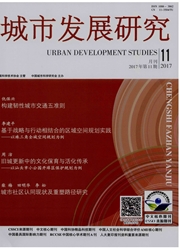

 中文摘要:
中文摘要:
采用统计分析和探索性空间数据分析方法,在第四、第五、第六次人口普查乡镇街道数据的基础上,着重探讨了北京都市区2000年以来人口空间发展的新特征。研究表明,2000年以来,北京旧城区人口整体实现了正增长,改变了绝对数量不断下降的趋势,增加了人口疏解的难度。远郊区人口增速超过近郊,逐步演化为郊区化的主要承载空间,显示出远郊新城在集聚人口方面的吸引力。全局Moran指数显著为正且逐年减小,揭示人口的郊区化扩展,但2000以来这种趋势有所减弱。局部Moran指数揭示高-高类型集聚区以旧城区为中心逐步向外围扩展,新增的高-高类型区主要位于西北部和北部,减少的区域主要分布于二环以内。低-低类型区分布于都市区的外围,并且向西部的门头沟区和西南部的房山区逐步集中。说明新时期北京都市区人口空间发展存在大范围的集聚和小范围的扩散两种趋势,即人口从都市区外围向近郊及远郊新城集聚,同时由旧城中心部分街道向外围扩散。
 英文摘要:
英文摘要:
Based on 1990,2000,2010 census data,with the aids of exploratory spatial data analysis methods,the paper discusses the spatial distribution and trends of population density in metropolitan Beijing.It shows that the population in the urban core area increases slightly from 2000 to 2010,and the growth rate in outer suburb outpaces the inner suburb.Global Moran′s I of 1990,2000,and 2010 indicate that there is significant spatial clustering in Beijing.Local Moran′s I show that the high-high spatial clustering spreads out from the second ring road since 1990.New high-high clustering mainly locates in the Northwest and in the North,and the number in the urban core area drops.The low-low spatial clustering mainly locates in the fringe of metropolitan Beijing,and it continues to concentrate in Mentougou district and Fangshan district from 1990 to 2010.It indicates that population concentrate in inner suburb and the new towns in outer suburbs since 2000,at the same time,population outflow from the central area.
 同期刊论文项目
同期刊论文项目
 同项目期刊论文
同项目期刊论文
 期刊信息
期刊信息
